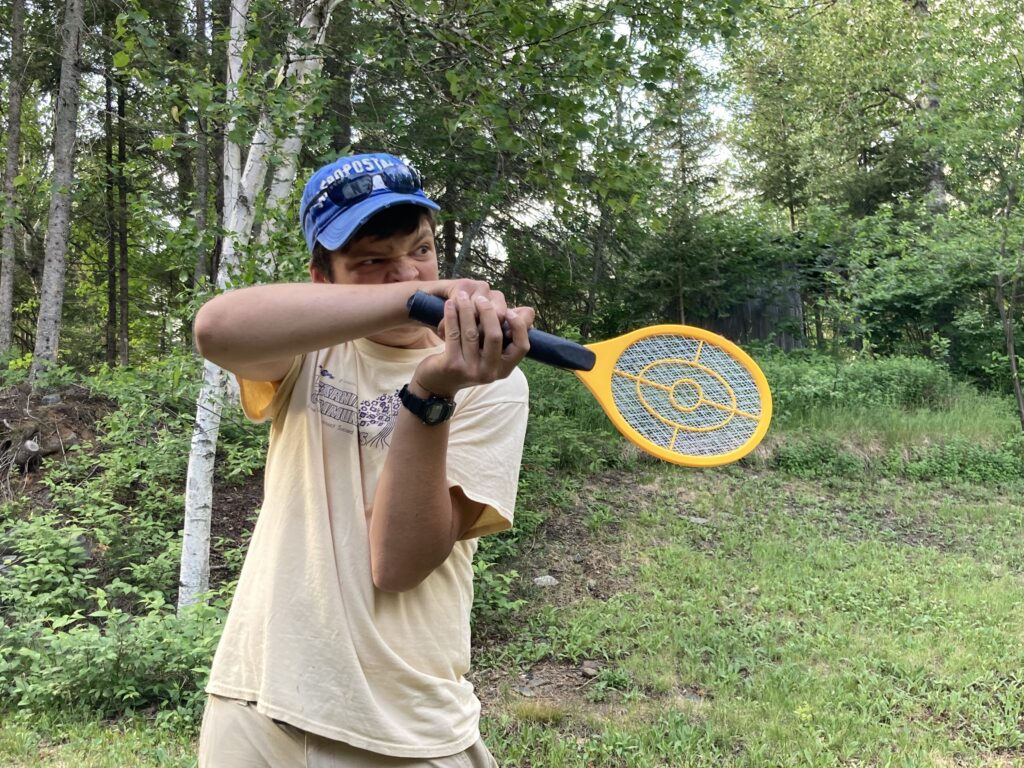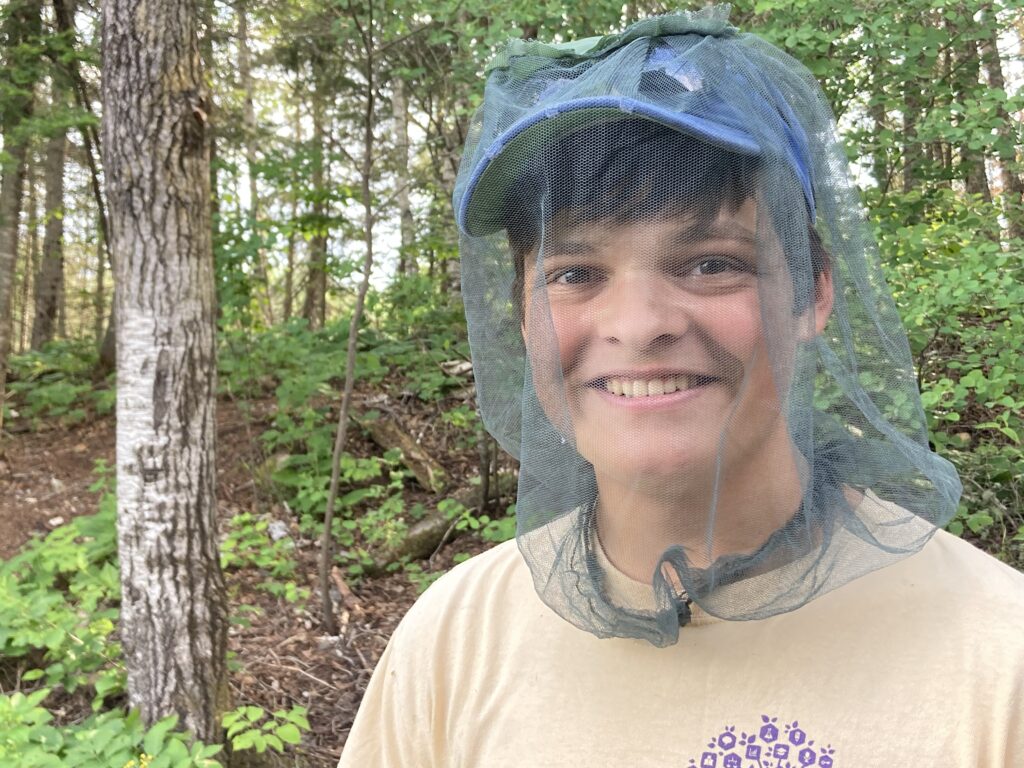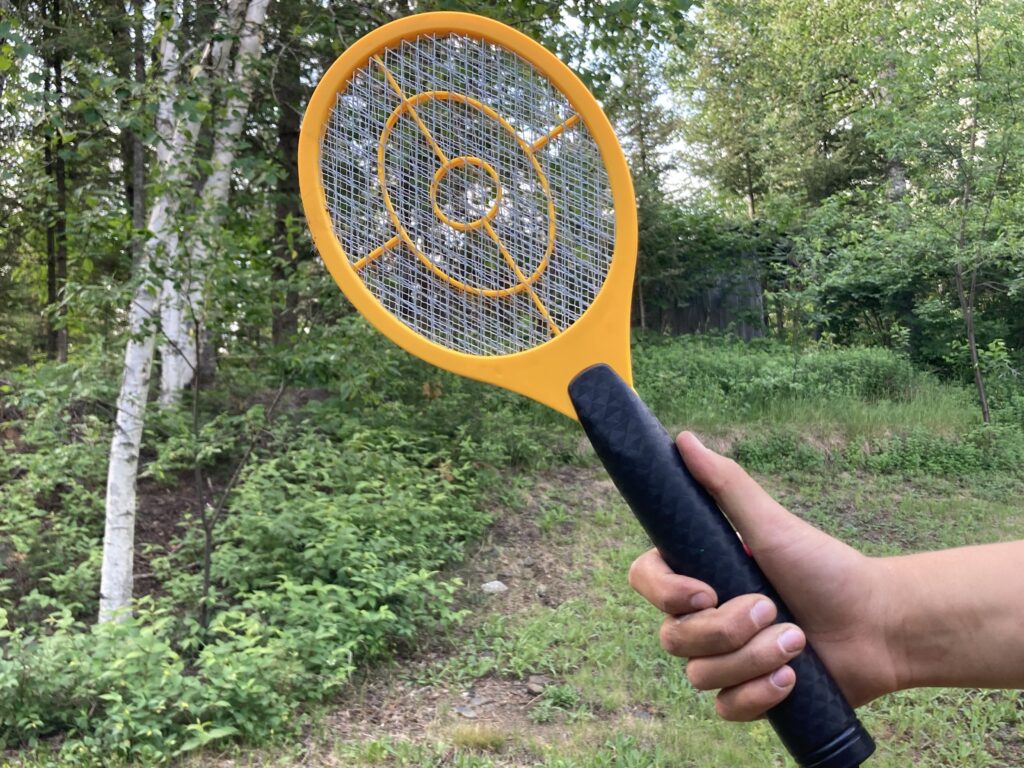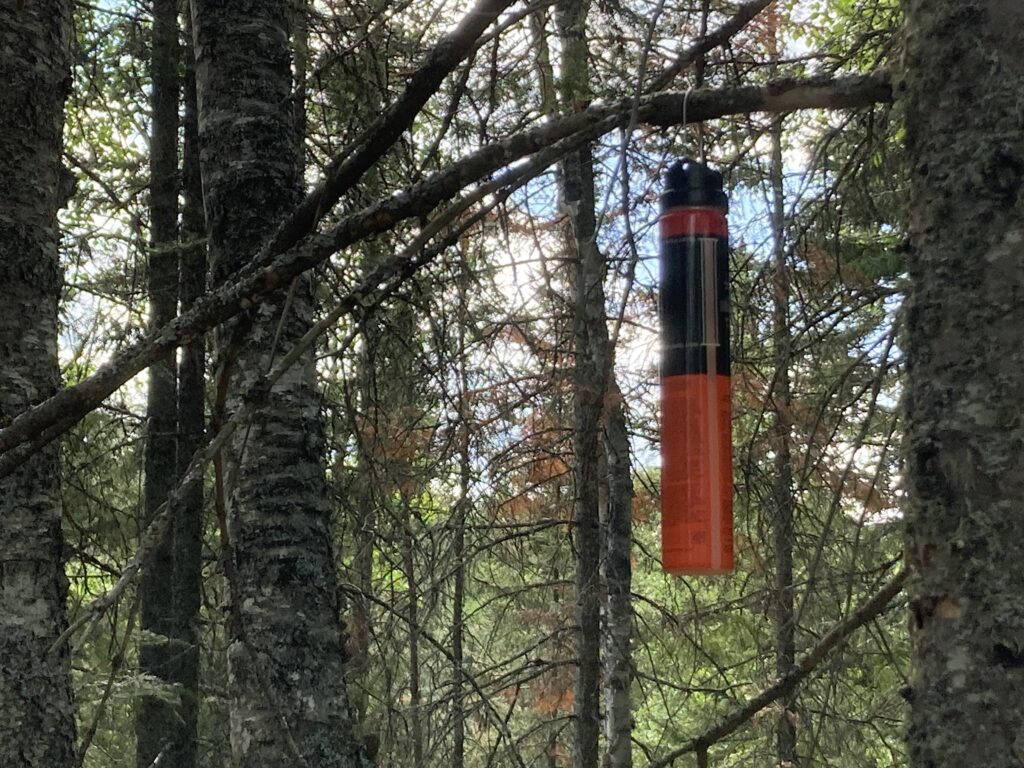Summer at Okontoe is beautiful, and it brings faithful visitors every year. Our most faithful visitors, though, are the ones we want to get rid of the most—bugs. But don’t worry—you can beat them!

Here are some ways to fight the bugs during your stay at Okontoe!
1. Wear Protective Clothing
Wear loose-fitting clothes that cover your arms and legs. Skin-tight clothing lets the bugs get through more easily. It’s also good to wear something that is snug at the ends of the arms and legs so that the bugs can’t get in through any gaps.
My family has noticed that black flies particularly like to bite your ankles. So we’d recommend wearing something to cover your ankles as well—long pants, socks, etc.
You can also use permethrin, which is a helpful repellent treatment for clothes and gear. You can buy clothes that are already treated with it, or you can treat it yourself. Remember, though, it is only for clothes and gear, NOT for skin!
2. Use Bug Nets

Bug nets are a great way to keep the bugs off! You can buy them for just your head or your torso. There are also some full body suits available.
Besides nets for your body, you can also buy large ones to hang around your bed or set up outside. There are a lot of great options! Here is a great place to start looking.
My family typically just uses head nets, and those work very well. Keep in mind, though, that the nets don’t repel the bugs on their own; they just keep them from landing on you. So they work best when you wear repellent with them. Make sure to wear a hat under the head net to keep it—and the bugs—further from your face. Also, make sure to close it all the way so that no bugs come through the edges!
While I personally haven’t tried one of these yet, I’ve heard great things about the Original Bug Shirt®. It’s on the pricier side, but more durable than the cheap ones made out of mesh only. (Check out the end of this post to see local stores that sell this and other bug products!)
3. Repellent is Your Friend
DEET
Ah, the smell of summer—DEET.
While it’s not your only option, DEET is the standard repellent and works well—better than anything I’ve tried so far. It is a chemical that keeps bugs from smelling human scent, according to Healthline.com. Healthline also says, “DEET is recommended for people at risk of mosquito bites carrying any disease.”
Healthline adds that it isn’t harmful to humans when it’s used properly. The main thing is to make sure not to ingest it by following these tips:
- Don’t put it on your hands or close to your mouth.
- Don’t put on too much.
- Wash your hands before eating or when you come back inside.
According to Mr. Mister Mosquito Control, the time when these kinds of repellents might cause an issue is when the repellent has a higher concentration of DEET. It’s better to use repellent with a lower concentration, spray it lightly, and apply more later if needed.
As long as you keep these tips in mind, DEET is an awesome way to keep the bugs away! Wirecutter recommends Cutter Backwoods Dry as the best DEET repellent.
Picaridin
Another great option is picaridin. It’s a newer kind of chemical that mimics piperidine, which is found in black pepper (Mr. Mister Mosquito Control). It’s just as effective as DEET but doesn’t stink or leave a greasy residue on your skin, which DEET often does. The two kinds of repellent are generally similar in price, although picaridin may sometimes be a bit more expensive.
Natural Options
There are a lot of natural options for repellent, too, although they generally don’t work as well as chemical ones (especially up here, since there are just so many bugs). Healthline has great information on different kinds of essential oils that can be used as bug repellent.
Citronella is one of the most common natural repellents, but I have generally found that it doesn’t work as well as DEET or other options. Healthline, though, says its effectiveness depends on how it’s made. It can be as effective as DEET, but if it’s not made right, it’ll just evaporate.
Fun Fact from Healthline: Some research found that catnip was 10 times more effective than DEET!
4. Defend Yourself with Zappers

My family loves to use handheld bug zappers. They look like tennis rackets, but the wire mesh is electric, and when you press a button on the handle, they zap any bugs that come in contact with the mesh.
Although they work great, I would recommend using them along with repellent and/or a bug net. They don’t kill a ton of bugs on their own.
You can also get area zappers, which use a UV light to attract the bugs and then zap them. Okontoe has one by the cabins. These work great, but make sure to keep them a little away from where you will be outside. Since they attract the bugs before killing them, you don’t want to be too close to where the bugs are gathering!
5. Set Up Spatial Repellents

Like the area zappers, spatial repellents can help with bugs in an entire campsite or larger area. Okontoe has several spatial repellents set up across camp. They are bait stations, which attract the bugs like the zappers do. They are in the woods a little way from campsites and cabins, but they help keep the bugs at bay all around where they are set up.
Thermacell® makes some of the best spatial repellents. They use butane fuel to heat up a repellent mat, which spreads around the area and keeps bugs away. It works great!
Repellent coils are another great solution. Once you light these small, handy coils, the repellent evaporates with the smoke and keeps bugs away from the area. They tend to be cheaper than Thermacell®, though I’ve found that they don’t seem to work quite as well. They still keep the bugs at bay, though!
6. Treating Bug Bites
In spite of our best efforts, we usually still come away with a few bug bites at the end of the day. So what helps soothe the itching?
Healthline has some great solutions:
- Rub apple cider vinegar on the bite.
- Apply a slice of raw onion or garlic.
- Apply creams like calamine lotion or hydrocortisone.
I’ve also found that running warm water over the bites can be soothing, too. Even just going for a swim in Bow Lake seems to help!
If you know of any other solutions, we would love to hear them!
7. Where to Buy Bug Stuff
Clicking on the names of the companies I’ve mentioned above will bring you to their websites, where you can buy a lot of the helpful tools we’ve talked about here. You can easily find and buy all of the things mentioned here online.
Grand Marais also has some great stores that stock up on bug stuff every year, particularly these three:
Bugs at Okontoe
Now, there are diseases that bugs can carry—Lyme disease from ticks and West Nile virus from mosquitoes being some of them. While it’s always good to be careful, there actually have not been many cases of Lyme disease in Cook County over the last 20 years (TickCheck). The risk for West Nile Virus is even lower (Minnesota Department of Health). So make sure you check for ticks and prepare for the bugs, but know that they are usually not dangerous here.
If you want to avoid the bugs as much as possible, you should know that June is usually our buggiest month. Everything is just hatching, and the black flies tend to be particularly bad. As the summer goes on, they become manageable and start disappearing, and by the beginning of September, they are basically gone.
Bugs are annoying, but with a little preparation, they can be kept away. Come enjoy the outdoors here at Okontoe!
A word from a mosquito…
Article and photos by Kaylee Selin
Model: Aidan Selin

3 thoughts on “7 of Our Best Tips for Battling the Bugs”
Comments are closed.